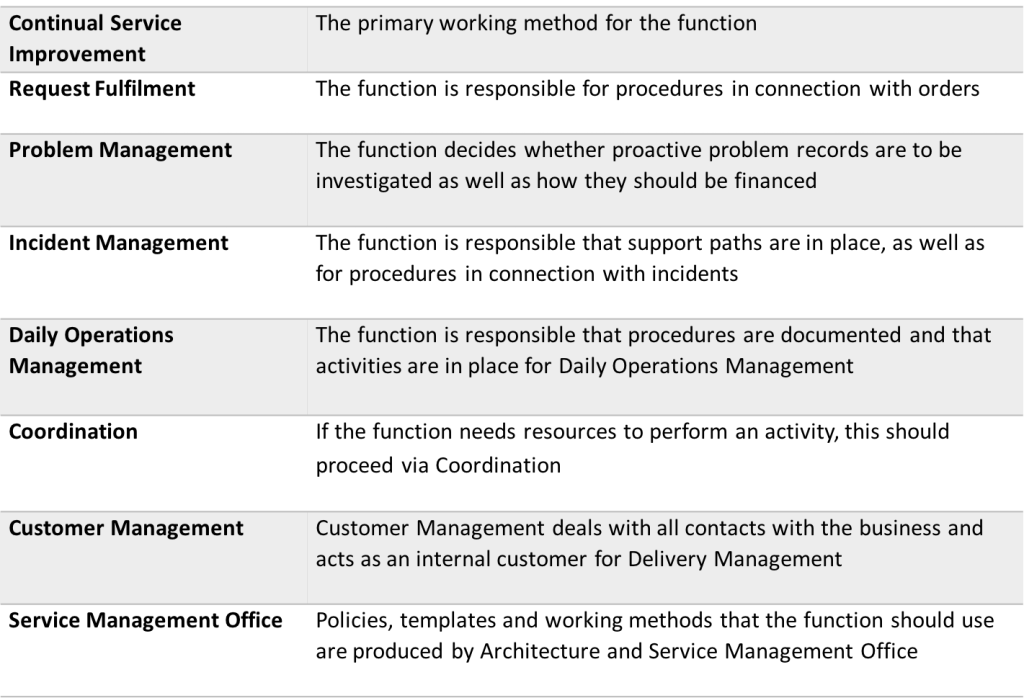Everything included in an IT environment needs to be maintained so that it does not degenerate. Hardware becomes old and worn out, software needs constant updating and documentation which is not maintained becomes obsolete and worthless over time.
Delivery Management is the function which governs and leads production of the IT services at tactical level. The function ensures that everything is documented, that procedures are used and that processes are followed. The function should continually improve efficiency and also govern and prioritize the everyday work.

The function should prioritize internal efficiency. This entails devoting all energy to producing as effectively as possible through improving procedures, updating documentation, cutting costs and also continually evaluating and implementing improvements.
To ensure that this is manageable in a major IT organization, the function is divided into several different groups, with each grouping responsible for its part of the IT environment. How the division takes place is not important, however, it is very important that everything in the IT environment is under the responsibility of one of the groups. These groups are usually called administration groups in IT organizations.

Purpose
One purpose of the Delivery Management function is to act as executive body at the tactical level for production of IT services. The function’s responsibility is to measure and govern production and also to continually improve efficiency, both in terms of cost and quality.
Another purpose of the function is to keep the production process unified. In recent decades, development of virtual machinery and centralized solutions has led to almost everything being dependent on the IT environment. This means that all changes implemented run the risk of affecting another part of the IT environment outside your own area of responsibility. In this context, the function has the task of coordinating and making priorities between all groupings included.
Responsibility
The Delivery Management function is responsible for everything involved in maintaining and producing the IT services. Besides hardware and software, this also comprises documentation, procedures and processes that are required to enable the operational level to perform production work.
This entails locating all documentation and all procedures that are required to enable the operational level to run the IT environment within the framework of the function’s responsibility.
The responsibility also entails all suppliers of IT services to production meeting the agreed levels and contributing to value creation in the business. If a part of the IT production process is outsourced, then it is the Delivery Management function that is the primary contact for the suppliers at tactical level.
Activities and working method
The group or groupings formed within the Delivery Management function should be viewed as virtual groupings and not as organizational units. As the groups are set up on the basis of delivery content or technical area, and as it must be possible to change them quite frequently, it would be very difficult and administratively demanding if the groups constituted organizational units.
The groupings are formed on the basis of a defined responsibility where staff from different parts of the IT organization get together on a regular basis, for example once per week.
The activities in the group consist of continually measuring, following up and improving production within the specified responsibility. This is facilitated through using service management and ticket management in the Continual Service Improvement process.
Input
Inputs to the function consist primarily of requests and requirements from the Customer Management function. But also of reports, measurement data, errors detected, proposals for improvement and requests from the IT organization as a whole. In order to structure all the issues that are received, the Continual Service Improvement process is used.
Output
The overall output from the function is cost effective production of qualitative IT services. More specifically, the output consists of:
- Documentation of supporting services and products
- Investigations of problem records in Problem Management
- Improvement projects implemented
- Procedures for operation and maintenance of the IT environment in Daily Operations Management
- Procedures for measures and escalation in Service Desk and Incident Management
- Procedures for implementation of orders in Request Fulfilment
- Prioritization of resources at operational level
Documentation
All documents produced by the function must be available in a business system. The most important documents are:
- Service documentation for supporting services and products containing:
- Description of the service/product
- Daily operations management
- Service levels
- Orders to Request Fulfilment
- Standard change
- Support routes
- Information regarding suppliers
Relationships with other processes and functions
Delivery Management has links to many other processes and functions. The most common are listed here:


